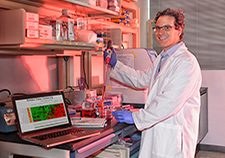Office of Research & Development |
 |

VA Research Currents archive
October 14, 2014

Dr. Seth Brodie, with VA and Emory University, is studying genetic patterns that predict response to chemotherapy. (Photo by Adam Hernandez)
Researchers at the Atlanta VA Medical Center and the departments of hematology and medical oncology at Emory University's School of Medicine have found evidence that an alteration in a common gene could help predict how well patients with lung cancer respond to treatment.
The study, published Sept. 15, 2014, in the journal PLOS One, found that patients with non-small lung cancer (NSLC) who had variations of the gene caveolin-1 tended to respond more favorably to chemotherapy than those without the alteration. Those patients also tended to have higher survival rates.
Caveolin-1 is a membrane-bound protein that is a key structural component of the caveola—Latin for "little cave." The caveola's job is to act as a sort of gatekeeper to help regulate traffic and out of the cells. Highly active caveolae mean more traffic; depressed ones mean less.
The study showed that cells with inactivated caveolin-1 tended to be more sensitive to a specific type of chemotherapy commonly used to treat NSLC.
"We discovered that hyper-methylation of the caveolin-1 gene in advanced lung cancer is a marker for taxane sensitivity," says Dr. Seth Brodie, a postdoctoral fellow at both the Atlanta VA Medical Center and Emory University.
Bottom line: The more sensitive cancer cells are to chemotherapy drug, the more effective that drug will be. "Right now taxane-based chemotherapy is the first-or second-line drug to be used in lung cancer," says Brodie. "If we can predict which patients will be most receptive to the treatment, then we can bolster effectiveness and limit the number of patients who have to deal with the side effects of chemotherapy."
What's more, because cancer patients and their doctors are often battling against time as well as the disease, the ability to quickly identify not only what treatments will be effective, but also which ones won't, gives patients the ability to change treatment options sooner rather than later.
"These kinds of predictive biomarkers hold the promise to better selecting what treatment to give what patients," says Brodie, "and that means higher rates of survival."
Between 1999 and 2010, 178 patients at the Atlanta VAMC received platinum plus taxane-based chemotherapy for stage IV NSLC. Of those, 49 had measurable data. "Hyper-methylation of caveolin-1 was present in 35 percent," says Brodie. "And basically, if you had that trait, you were 82 percent more likely to survive."
"That's not to say that someone without this marker can't benefit from the drug," says Brodie. "It just changes the probabilities of success, and with cancer, the sooner you can find an effective treatment, the better."